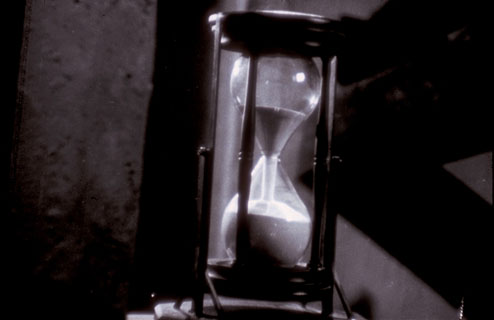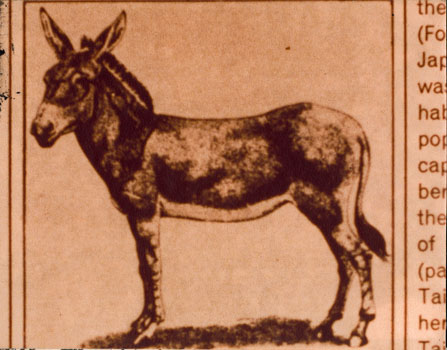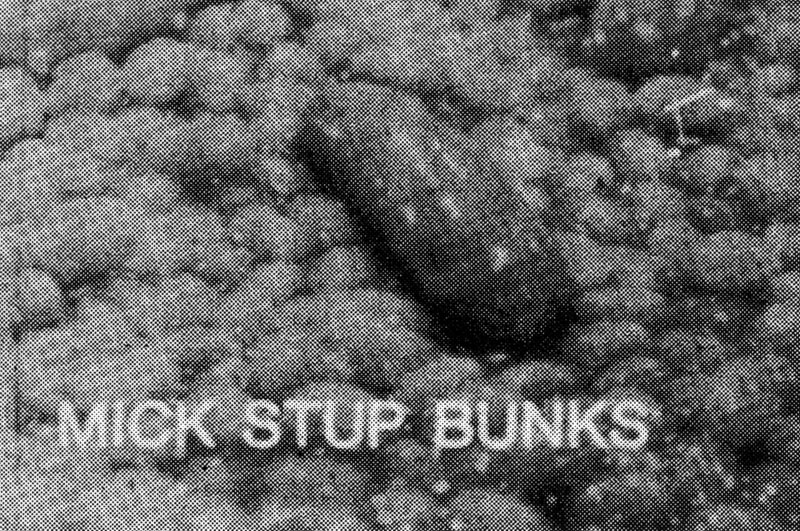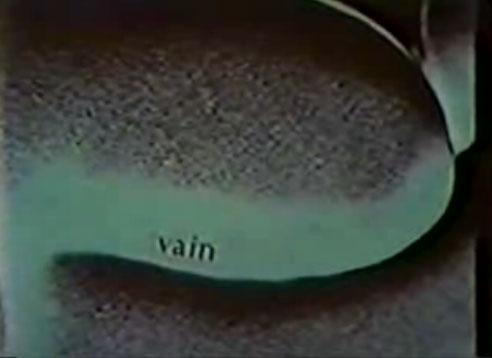
(DE)CODING
5 November 2009, Independent Film Show 2009, Napoli (IT).
Curated by Stoffel Debuysere and Maria Palacios Cruz.
“It’s about the unities of similarities. It’s about sameness in confusion. It’s about logic in chance. It’s about structure and logic”.
(Jonas Mekas on Zorns Lemma)
(DE)CODING plays with cinema’s ability and potential to generate associations, may they be intentional or not. This programme brings together a series of films that explore the capacity of images and words to create meaning, even when attempts are made to release them from the constraint of narrative, or in other words from the constraint of “making sense”. Images and words can’t help making meaning “before our eyes”, for we will always try to look for their sense and purpose.
In cinema, this is very much connected to the idea of montage, the ordering principle that creates continuities and discontinuities between images, sounds and text. But some associations escape the control of the editor. As Morgan Fisher points out “any succession of shots, no matter how disparate, brings into play the principles of montage. That cannot be helped. Where there is juxtaposition we assume specific intention and so look for meaning. Even if there is no specific intention, and here there is none, we still look for meaning, some way of understanding the juxtapositions.”
How does meaning result from a linear organization of images? Is there such a thing as a logic of chance? Does every random succession of film bits imply a unity, an order within chaos, a secret route to the imagination? Is narrative, as Hollis Frampton suggested in his so-called “Brakhage’s theorem”, a fixed axiom in cinema? : “For any finite series of shots (’film’) whatsoever there exists in real time a rational narrative, such that every term in the series, together with its position, duration, partition and reference shall be perfectly and entirely accounted for”.
The works in this programme propose a playful approach to concerns generally associated with “structural film”. On one hand, these are highly structured, quasi hermetic works. On the other, they are full of humour and wit. They ask the viewer to take up, within the practice of spectatorship, an expansive attitude towards the creation of meaning. We are invited to participate and solve perceptual puzzles, interpret them, and above all construct unity out of their diversity.
(DE)CODING is composed of two parts. The first presents four short films by Thom Andersen & Malcolm Brodwick, Morgan Fisher, Robert Nelson (all four Californian) and British filmmaker John Smith. Thom Andersen & Malcolm Brodwick’s — ——- and Morgan Fisher’s ( ) are works that explore the power of a rule as a structuring principle of montage, suggesting the possible new meanings that result of the reordering of images and sounds. Smith’s Associations and Nelson’s Bleu Shut are also works that deal with issues of order, but they are principally concerned with language, and with the confrontation of text (may it be spoken or written) with imagery. These two films serve as a lively introduction to a work both concerned with language and structure, Hollis Frampton’s Zorns Lemma which will be screened in the second part of the programme.
1st part
Thom Andersen and Malcolm Brodwick
— ——- (aka short line long line)
US, 1966-67, colour, sound, 11’

“A documentary about rock ‘n’ roll. Documentary material organized by a predetermined structure. A sequence of picture-sound equations with randomly chosen terms. Vertically, — ——- is completely structured; horizontally it is completely random. A pastiche of cinematography, a parody of montage. 1:2. 3:7. Right, left. Right to left-left to right. Up-down. Stasis, motion. Orange, magenta. Yellow, blue. Red, green. Magenta, orange. Blue, yellow. Green, red. 1:2, 1,5:3, 2:4, 3:6, 5:10, 8:16 . . .” (Thom Andersen)
Morgan Fisher
( )
US, 2003, 16mm, colour/b&w, silent, 21’

“The origin of ( ) was my fascination with inserts. Inserts are a crucial kind of shot in the syntax of narrative films. (…) I wanted to free the inserts from their stories, I wanted them to have as much autonomy as they could. I thought that discontinuity, cutting from one film to another, was the best way to do this. It is narrative that creates the need for an insert, assigns an insert to its place and keeps it there. The less the sense of narrative, the greater the freedom each insert would have. But of course any succession of shots, no matter how disparate, brings into play the principles of montage. That cannot be helped. Where there is juxtaposition we assume specific intention and so look for meaning. Even if there is no specific intention, and here there is none, we still look for meaning, some way of understanding the juxtapositions. “ (Morgan Fisher)
John Smith
Associations
UK, 1975, 16mm, colour, sound, 7’

“Associations plays with meaning, not in its construction but rather in the absurdity of meaning as a given, of packaged knowledge. Using the text from ‘Word association and linguistic Theory’ by Herbert H. Clarke and images from colour supplements, the film creates, through associations, a rebus where words are replaced by pictures in a seamless continuum of puns.(…) The ubiquitous connections, often humorous, displace meaning in very much the same way as nineteenth-century English nonsense poetry, forsaking understanding for the benefit of a more ephemeral psychological gymnastics where ambiguity becomes the determining factor.” (Michael Mazière)
Robert Nelson
Bleu Shut
US, 1970, 16mm, colour, sound, 33’

“In Bleu Shut Nelson invented a form which would be capable of holding together many different kinds of film while maintaining their integrity as home movies, advertisements, quotations, etc. In Nelson’s inflection of the participatory form, the very question of synthesizing the materials of the film is handed directly to the viewer. In the ironic structure he provides, all images share a relationship to one minute subsections of the film. Screen time is affirmed in two ways. A small transparent clock appears in the upper right-hand corner of the screen, measuring the minutes and seconds throughout the film. That measurement is reinforced by a number which flashes briefly on the screen at the beginning of each new minute”. (P.A. Sitney)
2nd part
Hollis Frampton
Zorns Lemma
1970, 16mm, colour, sound, 60’

Zorns Lemma is arguably the veritable master piece of American filmmaker Hollis Frampton. It combines a number of intellectual and aesthetic issues that Frampton had already explored in his earlier films and photographic work, especially his fascination with epistemology and set theory – the title is a reference to mathematician Max Zorn’s equivalent to the Axiom of Choice. The film is structured according to an axiomatic system, expressed both in ontological and structural codes. The central part consists of images of words, assembled in alphabetical order – a reference to the Encyclopedic movement and the arbitrary tendency to categorize the World on the basis of the first letter of the object name. The ideograms gradually make place for arbitrary images, as a result of which an ingenious game between language and image is installed, inciting the audience to dismantle the control structures and discover the logic of chance.
“For one or more things to be “ordered,” they must share a perceptual (provable) element. So there are many ordered subsets within the set of all elements that make up the film. There is the subset of all “abstractive” elements (the words, if they are seen as merely “list-able”) and the subset of all “fictive” elements (the images, if they are seen merely as deliberately “made”). But what you see (consciously) most of all is the one-second cut, or pulse. So that what I imply is that the maximal fully ordered subset of all film (which this film proposes to mime) is not the “shot” but the cut – the deliberate act of articulation. (…) Zorns Lemma is hierarchic, in that it proposes a possible meaningful “tour” of all elements within a set with regard to only one operation – discernment of their “ordering,” or the relative preponderance of their shared qualities.” (Holllis Frampton)